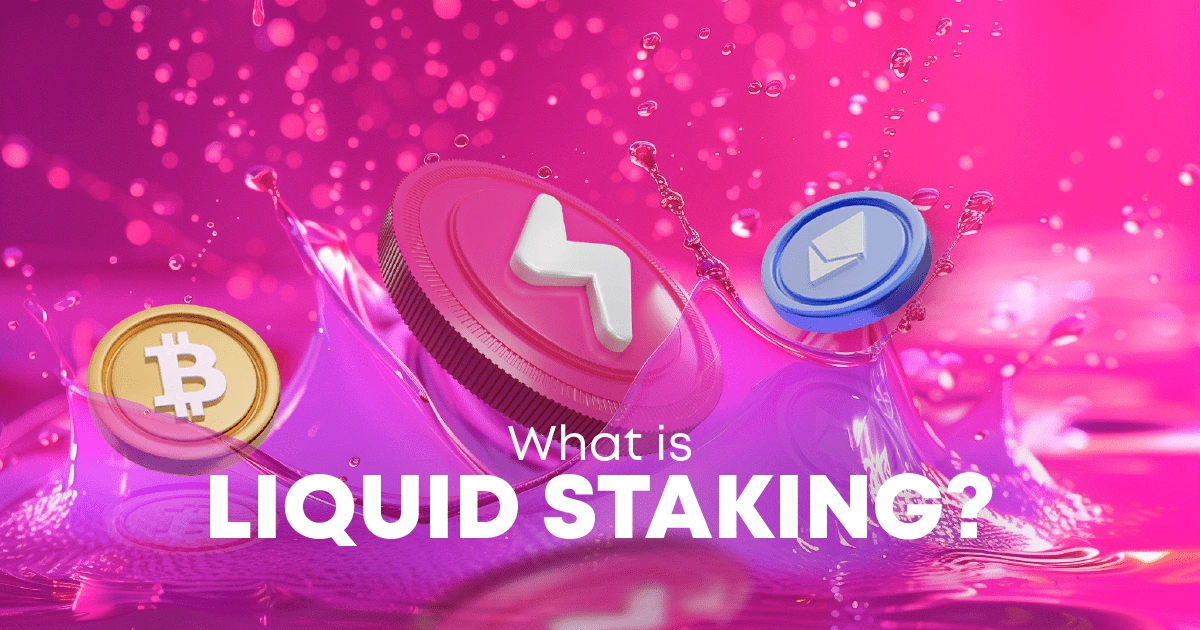
What is Liquid Staking?
DeFi, or decentralized financial instruments allows asset holders to make passive income. Staking is one of the most common ways to earn money in DeFi. Liquid staking is the process of getting an item in return for staking a cryptocurrency on a proof-of-stake blockchain. In this article, we'll learn more about liquid staking, and its challenges with traditional staking.
How does Liquid Staking Work?
Staking helps to protect blockchain networks, such as PoS systems, by locking up some of your digital currencies to confirm transactions. Usually, this locks up your assets, but liquid staking makes it more flexible, allowing you to keep using your digital currency while supporting the network.
Liquid staking offers the same benefits as conventional staking, such as receiving rewards and supporting blockchain networks, while increasing flexibility. When you stake your assets, you receive Liquid Staking Tokens (LSTs), which represent your staked assets and the interest they earn. Their key advantage is liquidity: you can trade these LSTs or use them in a variety of decentralized finance (DeFi) apps, leaving your cash available for other activities.
This shift in staking is beneficial for those who want to use their assets more actively in the DeFi space.
Platforms that offer liquid staking, such as Ethereum, let you stake your ETH, receive LSTs, and then use these tokens in different DeFi protocols. This makes liquid staking more approachable and user-friendly, reducing entry barriers and offering the dual benefit of earning potential and liquidity.
Quick Recap:
Flexibility Without Locking: Get staking rewards while keeping assets accessible.
Derivative Tokens: LSTs represent your staked assets, useful in trading and DeFi.
Enhanced Liquidity: Use your staked assets freely in various crypto activities.
Seamless DeFi Integration: Integrate easily into the DeFi ecosystem for more opportunities.
Accessibility for All: An easy-to-understand process that welcomes beginners.
Benefits of Liquid Staking
Let's look at the benefits of liquid staking, starting with liquidity management, which is the most important benefit of the staking technique.
Maintaining Liquidity
Maintaining liquidity has various benefits:
- Asset Utilization: In liquid staking, your assets aren't locked away, but instead, they are converted into liquid staking tokens, which can be used in other crypto activities. This means you can simultaneously earn staking rewards while also leveraging those assets in other parts of the crypto ecosystem, such as in trading or lending protocols.
- Market Opportunities: The crypto market is highly volatile, and having access to your assets means you can quickly react to market changes. If the market is bullish, you can sell your assets to capitalize on high prices or buy more assets in a bearish market. Traditional staking will only allow such flexibility if your assets are locked away for a set period.
- Capital Efficiency: Liquid staking enhances capital efficiency allowing to put your assets to work in multiple ways simultaneously. Liquid staking tokens are also used as leverage to borrow other assets or lend them out to earn interest in addition to receiving staking profits.
- Reduced Risk: Easy access and their transfer can also help lower risks. For example, being able to sell or move your assets can be important in a declining market. Unlike traditional staking, where your assets would be locked regardless of market conditions, liquid staking offers this freedom.
- Increased Participation: The liquidity feature motivates more people to stake their assets due to easier entrance and exit options compared to traditional staking. So that the security and stability of the blockchain network will increase.
- Enhanced DeFi Interaction: Within the decentralized finance (DeFi) ecosystem, liquid staking tokens are easily utilized. Here staking operations are integrated with the wider environment, boosting broader use cases, and building a stronger, more linked financial ecosystem.
- Attractiveness to New Investors: The possibility get cash easily and gain from staking while using assets for other financial purposes can draw in new or uneasy investors, and this will result in more funds proceeding into cryptocurrencies and DeFi.
All these factors lead us to understand that liquid staking enables asset holders to spend their cash more efficiently and minimize risks in the cryptocurrency and DeFi markets. However, it is critical to understand how liquid staking addresses cutting risks.
Reduced Slashing Risk
Slashing is a blockchain concept that you should be familiar with if you plan on staking your assets. Simply, it is a cutting act of punishing validators who violate the rules or act against the network's interests. So, how can liquid staking help to reduce risk?
- Distributing the Risk: In traditional staking, your assets are often held by a single validator, which makes you vulnerable to the slashing risk associated with that specific validator. Liquid staking protocols distribute the assets across multiple validators. So, if one validator is penalized, the impact is less damaging to your overall staked assets.
- The Power of Pooling: Liquid staking allows your assets to be part of a larger pool spread among several validators. Think of it as diversifying your investment portfolio. By spreading the impact of a single validator's penalties throughout the pool, your personal risk is greatly minimized.
- Added Insurance Benefits: Some liquid staking platforms offer insurance funds as a safety net. If a validator gets slashed, this fund helps cover the loss, offering an additional layer of protection you wouldn’t get in traditional staking.
- Better Behavior from Validators: Liquid staking promotes good behavior among validators. When validators know their actions have consequences for a large community, there’s added pressure to play by the rules, reducing the slashing risk for everyone involved.
- Lowering the Educational Barrier: Uncertainty and lack of understanding about slashing risks can discourage potential stakers. Liquid staking platforms offer user-friendly interfaces and reduced risk, making it easier for newcomers to dig deep into the staking pool.
Quick Recap:
- Risk is distributed across multiple validators
- Pooling assets reduces the impact of a slashing event
- Insurance funds offer extra security
- Validators should be encouraged to act responsibly
- Staking is more accessible for newcomers
Liquid staking is designed to decrease risks through multiple techniques, making it a safer and better option for blockchain ecosystem players.
Composability in DeFi (Decentralized Finance)
Liquid staking allows your assets to participate in different DeFi activities. Composability in DeFi means these different DeFi protocols and platforms can work together smoothly, creating a flexible financial system. Here's how the liquid staking helps to enhance it:
- Tokenized Staked Assets: Liquid staking transforms your staked assets into tokenized versions calling them liquid staking tokens which can interact with different DeFi platforms like lending pools and prediction markets, expanding your financial options.
- Increased Liquidity: The non-lockup nature of liquid staking adds more liquidity to the DeFi space. The freedom to stake your assets while simultaneously deploying them in DeFi applications makes the ecosystem more fluid and capital-efficient.
- Enhanced Collateral Utility: With liquid staking tokens, you're not just earning staking rewards. You can also use these tokens as collateral in other DeFi applications. This creates a multi-layered utility for your staked assets, extending their functionality beyond a single protocol.
- Distributed validator technology (DVT) staking - The staked assets in liquid staking crypto aren't tied to only one validator. Instead, they're spread out among several, boosting security and staying true to DeFi principles. This setup enables flexible use of assets throughout the DeFi ecosystem.
- Interoperability: Liquid staking acts as a catalyst for this interoperability, smoothing the flow of assets and interactions across various DeFi platforms.
- Encouraging Participation: Liquid staking's composability and liquidity draw more users into the DeFi sector which fosters stronger and more varied financial solutions within the ecosystem, developing its growth.
Here is how the liquid staking boosts DeFi's composability in several ways. It tokenizes staked assets, enhances liquidity, provides diverse collateral utilities, and incentivizes participation, fostering a more interconnected, resilient, and dynamic DeFi ecosystem.
Earning Staking Rewards
Liquid staking creates a more interactive and financially rewarding staking experience for everyone involved. Here's how you can maximize your income through this innovative approach:
- Token Representation: Your staked assets get transformed into Liquid Staking Derivative (LSD) tokens. You can trade these tokens or use them in other DeFi protocols. As you earn staking rewards, the value of these LSD tokens also rises. If you start with 2 FTN and convert it to 2 stFTN, with an annual return rate of 5%, you'll have about 2.1 FTN at the end of the year.
- Secondary Revenue Streams: With liquid staking's liquidity, you have the flexibility to diversify your options. You can deploy your LSD tokens into liquidity pools to earn provider fees, utilize them as collateral to secure loans, or explore yield farming strategies to further enhance your earnings.
- Flexibility and Accessibility: Liquid staking offers the advantage of being able to stake and unstake assets without disrupting your initial deposit. This flexibility allows you to move your assets across various protocols to capitalize on the best earning opportunities available.
Enhanced Yield Opportunities
Liquid staking expands the possibilities for generating yield by seamlessly integrating with diverse DeFi platforms and strategies. Here's a full explanation:
- Additional Yield on Top of Staking Rewards: The significant aspect is that these tokenized assets have the potential to generate additional yield on top of your regular staking rewards. This occurs when you engage in other DeFi activities such as lending or providing liquidity.
- Yield Farming Strategies: Want to go beyond the basics? You can use your liquid staking tokens in specific yield farming strategies, such as adding them to liquidity pools on decentralized exchanges. This gets you a slice of the trading fees and can even open doors to unique yield opportunities in collaborations between liquid staking platforms and other DeFi services.
- Rebasing Mechanism: Some liquid staking services use rebasing to adjust the token supply, automatically upping your yield. If the yield goes up, the number of liquid staking tokens you own could increase, too, giving your earnings an extra lift.
Simplified Staking Process
If you previously thought of traditional staking as complicated, liquid staking is a breath of fresh air. Its two main factors are:
- Ease of Participation: Liquid staking is user-friendly. By joining a staking pool, all the tough stuff like choosing validators is handled for you. This simplicity attracts more people to stake their assets and explore the DeFi world.
- No Lengthy Unstaking Process: If you've ever dealt with the slow process of unstaking in traditional Proof of Stake (PoS) systems, you'll appreciate this: Liquid staking speeds up the whole unstaking process—no unnecessary delays or headaches.
Liquid Staking as a Service
Besides everything we've mentioned, there is Liquid Staking as a Service. It lowers the entry barrier, lets you dip your toes into other DeFi opportunities, and keeps things transparent and straightforward. All in all, it’s a more rewarding and hassle-free way to stake your assets.
Liquid Staking as a Service (LSaaS) takes care of the tough stuff so you can focus on earning. Here’s how it does that:
- Delegation to Service: You delegate your tokens to a service, like Lolik.com, that does the staking for you. You keep control of your funds while they handle the technical details.
- Token Representation: Your staked assets get turned into tokens. For example, Lido gives you stFTN tokens when you stake Fasttoken. These tokens are your ticket to earning in DeFi.
- Ongoing Earning: Just because you've outsourced, the staking doesn't mean you stop earning. Your liquid tokens gain value over time, matching the staking incentives you earn.
- Participation in DeFi Activities: You can use your staked asset tokens in DeFi activities like lending or providing liquidity. This means you can earn extra on top of your regular staking rewards.
- Reduced Technical Barriers: Got as little as 0.01 ETH? You can stake it. LSaaS levels the field, letting more people get into staking regardless of technical know-how or the size of their wallet.
- Transparent Management: Many LSaaS platforms operate transparently, ensuring everything is managed openly. You know what’s happening with your tokens at all times.
- Simplified Process: Ever get stuck on the technicalities of staking? LSaaS handles validator allocation and other technical aspects, making staking and un-staking easy.

Top 3 Liquid Staking Providers
The liquid staking landscape is quite dynamic, with various providers offering unique solutions to cater to the different needs of the staking community. Among them, we've followed the following three liquid staking providers for their services:
Lolik
LOLIK is a decentralized crypto staking platform designed to meet the evolving demands of the blockchain space. The platform specializes in both traditional Proof of Stake (PoS) and a newer method called Activity Staking, mainly geared towards smart contract applications.
LOLIK supports multiple blockchain networks, such as Ethereum, Polygon, and, notably, the Bahamut blockchain, which is based on a Proof of Stake and Activity (PoSA) model. Users can look forward to liquid staking, which means you don't have to lock away your assets indefinitely to earn rewards.
Additionally, the platform emphasizes user-friendliness and accessibility, aiming to simplify staking for both newcomers and experienced crypto users. It operates on the principle of decentralization, focusing on creating a transparent, secure, and community-driven environment for staking.
Lido
Lido aims to simplify the often complex crypto staking by removing minimum staking requirements that typically limit participation. Lido is run by a Decentralized Autonomous Organization (DAO), ensuring the platform remains secure and effectively managed. Lido offers its services across blockchains like Ethereum, Terra, and Solana, making staking more accessible and flexible for a broad user base.
Rocket Pool
Rocket Pool addresses two major difficulties in Ethereum 2.0 staking: the high financial and hardware requirements. When you stake, you get rETH tokens representing your staked Ethereum and any rewards you accumulate. These tokens are not idle; you can use or trade them within the Ethereum ecosystem. Rocket Pool creates a more distributed and efficient staking process by leveraging node operators to run validators. Innovative features like 8-ETH bonded minipools and options for Beacon Chain withdrawals further enhance the user experience, making it an attractive and user-friendly platform for Ethereum 2.0 staking.
What are the Main Risks of Liquid Staking
If, after reading through this article, you seriously consider liquid stake as a source of income, you should realize that, like any income-generating activity, LSD has its risks. And before diving deeper into this field, it is better to study and understand beforehand:
- Smart Contract Vulnerabilities: These are the backbone of liquid staking, though you can lose your staked tokens and rewards if they get hacked. Always make sure the protocol you're using has undergone proper security audits.
- Market Volatility: Like any investment, your staked tokens' value can go up or down. Market swings can affect your overall earnings, so don't put all your eggs in one basket.
- Regulatory Uncertainty: The rules around DeFi and staking are still being written. Legal changes can come out of nowhere, potentially affecting how these protocols operate or even their legality.
- Slashing Risk: Validators keep the network safe, but if they mess up, they can be 'slashed,' losing a portion of staked tokens. This affects you, too, reducing the value of your staked assets.
- Peg Loss Risk: Your liquid tokens should mirror the value of your original tokens. However, if they deviate from this and lose their peg, it can negatively impact their value and the trust associated with them.
- Centralization Risks: Some services might cut corners using centralized systems, compromising the network's security and trust levels. Always check how decentralized the protocol claims to be.
- Mismanagement Risk: A poorly run staking service can lead to losses. Whether through incompetence or shady behavior, bad management is a risk that can affect your investment.
If you're thinking about liquid staking, do your homework. Understand the ins and outs of the protocol you're using, keep tabs on the regulatory environment, and diversify to mitigate risks. Your due diligence today can save you a lot of headaches tomorrow.
Final Words and Key Takeaways
We've covered a lot regarding liquid staking, specifically LSD. So, the technology is indeed a breakthrough in the crypto industry. And despite the potential risks, LSD continues to grow, as does the dominance of liquid staking provider projects, demonstrating that the buzz around LSD will unlikely subside in the coming year.
Decentralized liquid staking protocols are a more viable alternative to pools and exchanges, as they help to maintain security without sacrificing decentralization..
FAQ
How to start liquid staking?
To start liquid staking, you should deposit your assets into a liquid staking protocol. In return, you'll receive derivative tokens, known as liquid staking tokens. These tokens represent your staked assets and any interest you accumulate. You can trade or use these tokens in other decentralized finance (DeFi) activities.
Is liquid staking safe?
It's generally considered to be secure if you use reputable platforms. Always do your own research and understand the risks involved. Consult the article above to see the top three liquid staking platforms.
What are liquid staking derivatives?
Liquid staking derivatives (often abbreviated as LSDs) are tokens you receive when you stake your assets in a liquid staking protocol. These tokens represent both your staked assets and any interest you accumulate to be traded or used in other DeFi activities.
Is liquidity better than staking?
Liquid staking offers more flexibility than traditional staking. You can earn staking rewards without locking up your assets and use your staked assets in other crypto activities. This makes liquid staking more advantageous for those who want both liquidity and earning potential.
Are there any minimum requirements for participating in liquid staking?
Some platforms make it really easy for anyone to get involved. For example, in Ethereum, you can stake any amount of ETH. There are no minimum requirements mentioned for most platforms.
Can I participate in other DeFi activities with my liquid-staked tokens?
Yes, you can. The liquid staking tokens you receive can be used in other DeFi activities like lending and yield farming without needing to un-stake.
Which cryptocurrencies can be used for liquid staking?
Multiple blockchain networks, such as Ethereum and Bahamut, are supported for liquid staking. Please consult each respective staking platform to see their network support.
Disclaimer: Includes third-party opinions. No financial advice.





